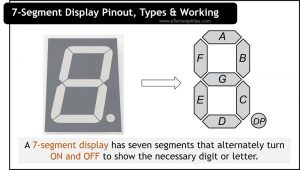Last updated on March 16th, 2024 at 01:41 pm
These displays, as their name implies, have seven segments that alternately turn ON and OFF to show the necessary digit or letter. The display segments are made up of a single LED or liquid crystal. These displays are widely used in electronic meters, digital clocks, home appliance displays, simple calculators, vehicles, and other electronic devices that show numerical data.
The display consists of seven segments, each of which is a “6-sided box” made of two thin pieces of metal, typically aluminum. Additionally, the parts are positioned at a right angle. A 7-segment display’s individual numerals are built of light-emitting diodes. By turning on specific LEDs we can generate numbers on display.
Table of Contents
Pinout
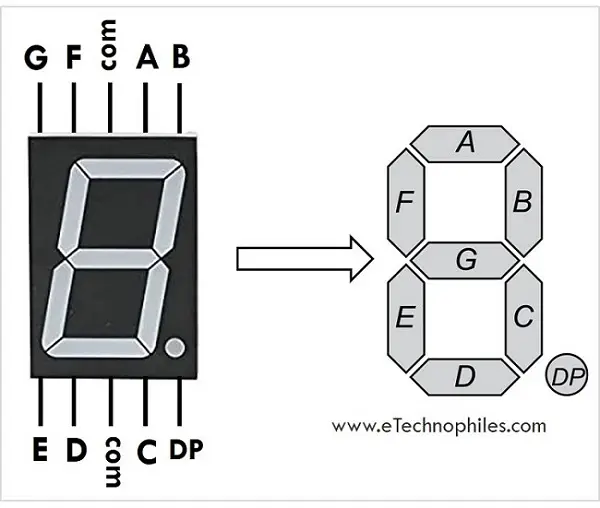
The seven-segment display consists of 10 pins. Out of these 10 pins, 7 pins are available to control the seven LEDs, one pin is for the common anode, other is for the common cathode. The last pin is for DP which is Decimal Point. The detailed pinout is given in the table below.
| Pin No. | Description |
| Pin 1 (e) | This pin is used to control the ‘e’ led section of the display. |
| Pin 2 (d) | This pin is used to control the ‘d’ led section of the display. |
| Pin 3 (Com) | Depending on the type of display, this pin is used to connect to Vcc or Ground. |
| Pin 4 (c) | This pin is used to control the ‘c’ led section of the display. |
| Pin 5 (DP) | This pin controls the display’s decimal point LED. |
| Pin 6 (b) | This pin is used to control the ‘b’ led section of the display. |
| Pin 7 (a) | This pin is used to control the ‘a’ led section of the display. |
| Pin 8 (Com) | Depending on the type of display, this pin is used to connect to Vcc or Ground. |
| Pin 9 (f) | This pin is used to control the ‘f’ led section of the display. |
| Pin 10 (g) | This pin is used to control the ‘g’ led section of the display. |
Types of 7-segment display
The arrangement of the 7 LEDs in 7 segment displays allows them to display numbers 0 to 9. As we connect an LED to the MCU using a series resistor, we can connect a seven-segment display in a similar way.
The only difference is that instead of connecting two pins of LEDs separately, a seven-segment display has one common pin (anode or cathode). So if we are using a 7-segment display we have to connect only 8 pins rather than 14 pins of individual LEDs.
These arrangements of pins in a 7-segment display can be again divided into two categories, i.e., the common anode and the common cathode.
Common Anode
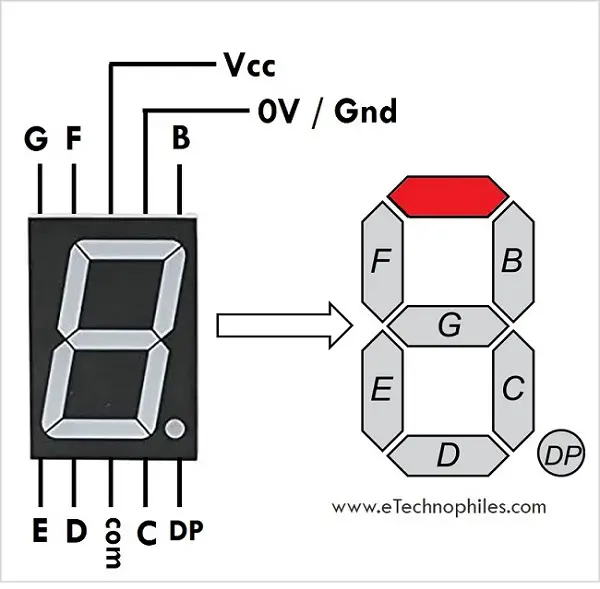
In this type, the cathode terminal of each LED is provided a different control signal while they all share a single anode terminal. As shown in the figure above, if we have to display the highlighted segment of the LED, +5V (Vcc) must be applied to the common pin while pin ‘a’ must be grounded (0V).
Note: The cathode terminal must be provided a low logic (0V) and the common anode terminal must have +5V source voltage in order for a segment to light up.
Common Cathode
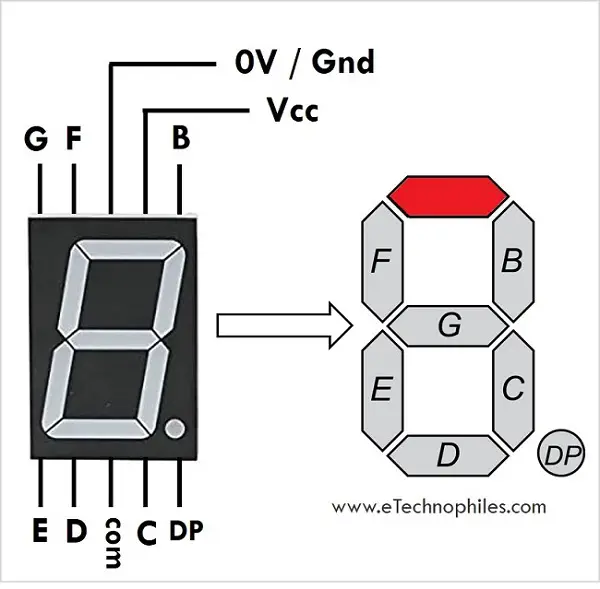
In this type, the anode terminal of each LED is provided a different control signal while they all share a single cathode terminal. As shown in the figure above, if we have to display the highlighted segment of the LED, the common pin must be grounded (0V) while pin ‘a’ must be provided +5V (Vcc).
Note: The anode terminal must be provided a high logic (+5V) and the common anode terminal must have a low logic level (0V) in order for a segment to light up.
Read also: PN2222 Transistor Basics- Pinout, Equivalent & Specs
7 Segment Display Truth table
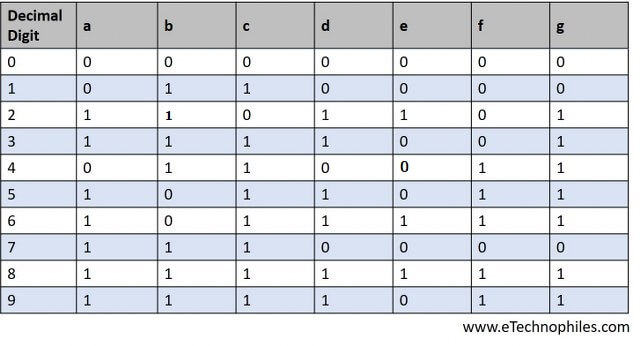
Below is a truth table for a seven-segment common anode display that contains individual segments lighted from a to g and decimal digits ranging from 0 to 9.
| Decimal Digit | a | b | c | d | e | f | g |
| 0 | 0 | 0 | 0 | 0 | 0 | 0 | 0 |
| 1 | 0 | 1 | 1 | 0 | 0 | 0 | 0 |
| 2 | 1 | 1 | 0 | 1 | 1 | 0 | 1 |
| 3 | 1 | 1 | 1 | 1 | 0 | 0 | 1 |
| 4 | 0 | 1 | 1 | 0 | 0 | 1 | 1 |
| 5 | 1 | 0 | 1 | 1 | 0 | 1 | 1 |
| 6 | 1 | 0 | 1 | 1 | 1 | 1 | 1 |
| 7 | 1 | 1 | 1 | 0 | 0 | 0 | 0 |
| 8 | 1 | 1 | 1 | 1 | 1 | 1 | 1 |
| 9 | 1 | 1 | 1 | 1 | 0 | 1 | 1 |
By giving specific logic, we can display specific decimal numbers on seven segment display. Read more
Datasheet
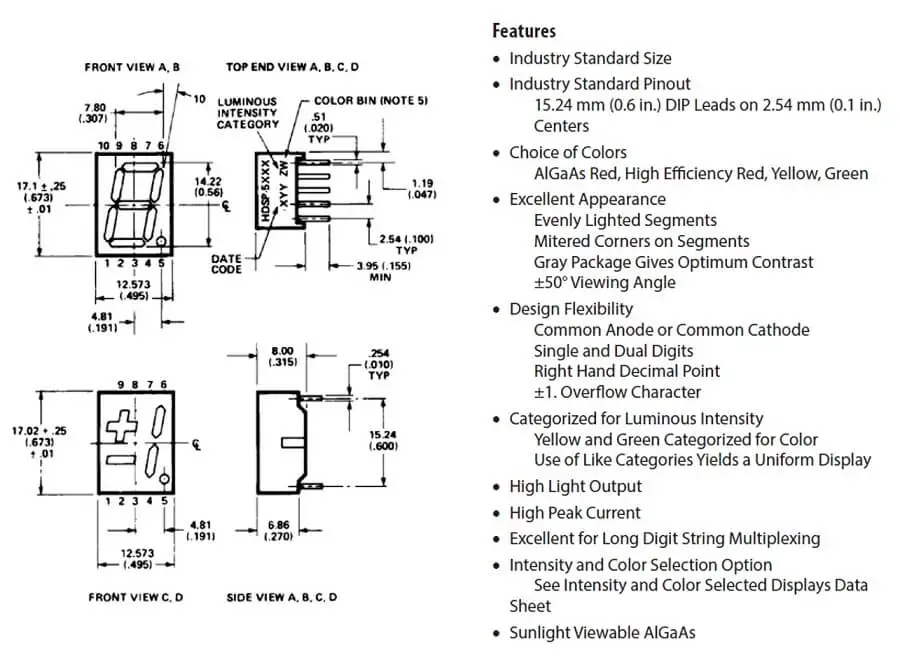
The 7-segment displays are designed for viewing distances up to 7 meters (23 feet). To download the datasheet of the display, click here.
Note: Please refer to the manufacturer-specific datasheet of the display.
Applications
Seven-segment displays are widely used in digital clocks, electronic meters, basic calculators, and other electronic devices that display numerical information.
FAQ
What other technology can be used to make a 7-segment display?
Liquid crystal displays (LCDs), LEDs for each segment, or other light-generating or control techniques like cold cathode gas discharge (Panaplex), vacuum fluorescent, and incandescent filaments (Numitron), may be used in seven-segment displays.
Which diode is used in seven segment display?
Light Emitting Diode is used in Seven Segment Display.
What is meant by a 7-segment display?
A seven-segment display is a type of electronic display device for displaying decimal numerals.
What is the bit size of a 7-segment display?
Two 32-bit registers are set up as the seven-segment displays. Each register’s individual bytes individually turn on and off the appropriate display segments.
Which IC is used as a 7-segment decoder?
The IC 7447 is frequently used for BCD to 7-segment decoding.
